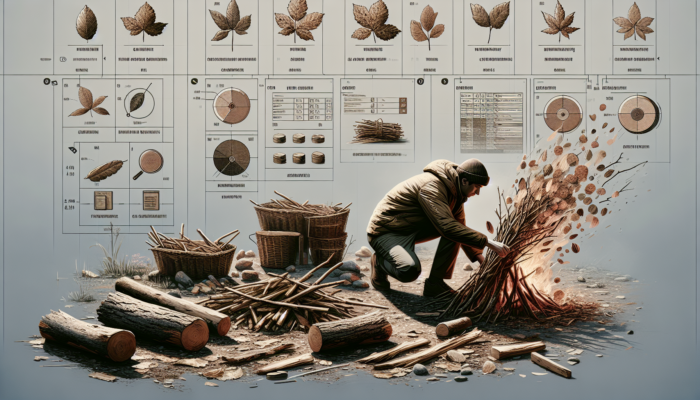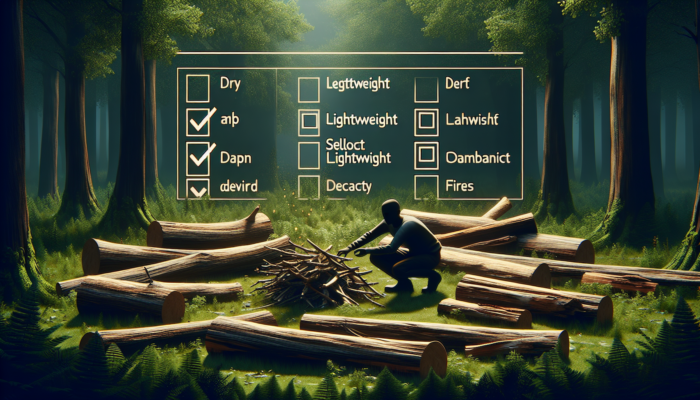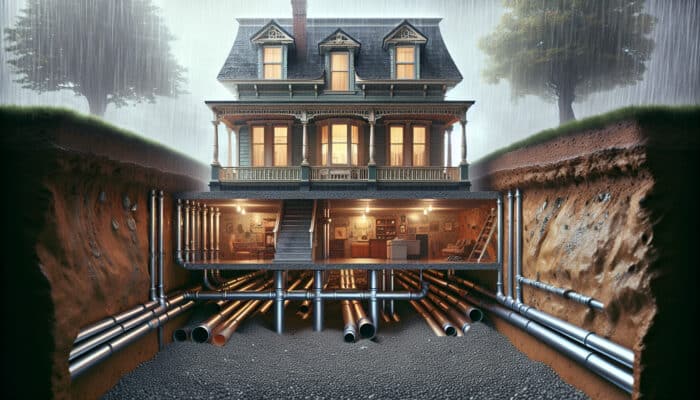How to Select the Best Spot for Safe and Enjoyable Wilderness Fire-Making
Finding the perfect location for fire-making in the wild is essential for ensuring a safe, enjoyable, and immersive outdoor experience. A well-chosen site enhances your safety and fosters a deeper connection with nature. As you prepare for your wilderness adventure, it is crucial to assess the potential benefits and risks associated with your environment. Understanding the surrounding landscape, including various terrain features and environmental conditions, is key to making informed decisions that contribute to a successful fire-making experience. Take the time to evaluate your surroundings to optimize both safety and enjoyment.
Understanding Wind Patterns and Weather Conditions for Fire Safety

The direction and strength of the wind play a vital role in ensuring both the safety and efficiency of your fire. Before lighting your fire, take a moment to carefully observe the prevailing wind patterns in your chosen area. Positioning your fire downwind of cooking or social areas minimizes smoke exposure, creating a more pleasant environment for everyone. Additionally, always check weather forecasts; if rain is expected, select a site with natural shelter to protect your fire from unexpected moisture. Look for natural windbreaks, such as large boulders or dense clusters of trees, which can significantly reduce airflow around your fire and enhance safety.
On a more technical note, having a solid understanding of local weather patterns can be invaluable for successful fire-making. Certain regions may experience abrupt weather changes, necessitating contingency plans like knowing how to quickly shield or extinguish your fire if conditions worsen. Trusting your instincts and prioritizing safety over convenience when selecting a fire location is essential for ensuring a rewarding outdoor experience. Always be prepared to adapt to changing conditions to keep your fire safely contained and enjoyable.
Finding Elevated, Dry Ground for Optimal Fire Performance
The effectiveness of your fire is heavily influenced by the quality of the ground beneath it. Elevated, dry areas are ideal, as they ensure your fire remains lit and less susceptible to rain or moisture. When scouting for a suitable spot, look for locations that have not been recently flooded or saturated by rain; hilltops and ridges often serve as excellent choices. Wet ground can absorb heat and moisture, extinguishing your flames before they have a chance to thrive, so prioritize dry terrain for a successful fire-making experience.
Moreover, consider the surface materials where you plan to build your fire. While leaf litter or dry grass can ignite quickly, they may also burn too rapidly, creating an unstable fire. Instead, opt for rocky or sandy surfaces that allow your fire to breathe while providing a stable foundation. As you assess the terrain, remain vigilant for natural barriers that can assist in containing your fire, preventing it from spreading uncontrollably and ensuring a safer experience for everyone involved in your outdoor adventure.
Creating a Safe Fire Perimeter for Enhanced Fire Safety
Establishing a secure perimeter around your fire is crucial and involves more than just choosing the right ground. A key step is to remove any flammable materials within a safe radius. This includes clearing away dry leaves, twigs, and other combustible debris that could easily ignite and lead to dangerous situations. Aim for a minimum distance of at least three feet around your fire site to ensure ample space for smoke to disperse and for people to gather safely, thereby reducing the risk of accidental burns or wildfires.
Additionally, consider the proximity of your fire to nearby structures, trees, or tents. A well-constructed fire should never be within striking distance of overhanging branches or shelters. The key to a successful fire-making experience lies in being proactive about safety; taking these precautions sets the stage for an enjoyable evening under the stars, free from concerns about your fire spreading uncontrollably. By prioritizing safety, you create a more relaxed atmosphere for everyone to enjoy.
Gathering Essential Materials for Successful Wilderness Fire-Making

No fire can thrive without the appropriate materials, and understanding how to gather these essentials is crucial for anyone looking to master fire-making in the wild. The process begins with securing the smallest components, like tinder, and gradually progresses to larger fuel sources, with each step being vital for achieving a robust fire that can withstand the elements. Proper preparation is the foundation of successful fire-making, so pay careful attention to the materials you gather.
Selecting the Best Tinder for Quick and Reliable Ignition
Tinder acts as the spark that ignites your fire, making the selection of suitable materials essential. Optimal options for tinder include dry leaves, grass, or birch bark, as these materials readily catch sparks and ignite quickly. Birch bark is particularly advantageous due to its natural oils, which facilitate ignition even in damp conditions, making it a reliable choice for various scenarios.
As you gather tinder, ensure that the materials are completely dry and free from moisture. A simple test is to crumble the leaves or grass; if they break easily, they are suitable for use. Avoid collecting green or damp materials, as these will hinder your fire's ability to ignite. When unsure, search for dead plants or fallen tree bark, which often provide excellent sources of tinder for your fire-making endeavors.
Another effective strategy is to carry pre-prepared tinder in your gear. For example, cotton balls dipped in petroleum jelly make excellent fire starters that ignite easily and burn long enough to catch larger kindling, significantly simplifying your fire-making efforts and enhancing your chances of success.
Collecting Quality Kindling for a Smooth Transition to Larger Fuel
Once you’ve secured suitable tinder, the next step is gathering kindling. This consists of small, dry sticks and twigs that facilitate the transition from tinder to larger logs. As you explore your surroundings, look for dead branches on the ground that can be easily snapped, as these will work effectively as kindling to help your fire grow.
When collecting kindling, aim for materials that are approximately the thickness of a pencil. This size allows for rapid ignition and burning, providing the necessary heat to ignite larger fuel sources. Layering your kindling in a crisscross pattern can enhance airflow, allowing the flames to grow more robustly as they transition to larger logs. A well-structured fire is key to a successful camping experience.
Remember, variety is crucial in this process. Collect kindling of different sizes to create a robust fire structure. Combining thinner twigs with slightly thicker sticks ensures a steady progression in fire strength and longevity, ultimately enhancing your experience of fire-making in the wild.
Finding Quality Firewood for Sustained Heat and Light

The final step in material gathering involves acquiring firewood. Larger, dry logs are essential for sustaining your fire once it is established. When searching for firewood, focus on downed trees or branches that are not in direct contact with the ground, as these are more likely to be dry and suitable for burning, providing the necessary fuel for your fire.
Select lightweight logs that produce a crisp sound when struck together, indicating they are dry and suitable for burning. Additionally, inspect for signs of rot or dampness; a log that feels heavy or has a spongy texture will yield minimal heat and create excessive smoke, potentially ruining your fire-making experience and causing frustration.
As you gather firewood, consider how long you plan to maintain your fire. If you expect to be in the wild for an extended period, collect more firewood than you think you'll need. Building an abundant supply allows you to maintain a consistent fire that provides warmth and light throughout your time in the wilderness, ensuring a comfortable and enjoyable experience for everyone involved.
Mastering Fire-Starting Techniques for Successful Wilderness Fire-Making
Mastering various fire-starting techniques is essential for anyone serious about enhancing their fire-making skills. Whether facing challenging weather conditions or wishing to impress your companions with your abilities, knowing multiple methods ensures you can adapt and succeed in fire-making in the wild. Each technique has its own advantages, allowing you to choose the right one based on your circumstances.
Using a Reliable Firestarter for Quick and Easy Ignition
The most straightforward and dependable method for fire-making in the wild is using a firestarter, such as a lighter or matches. This technique is particularly beneficial in wet or windy conditions, where traditional methods might not be as effective. When using a lighter, aim for one that is windproof, especially if you anticipate breezy environments that could complicate your efforts and hinder your success.
An important aspect of using a firestarter is preparing your materials in advance. Ensure your tinder is well-arranged to allow easy access to flames. Light the tinder and observe as it ignites, sending flames upward to catch the kindling. Always keep a backup firestarter on hand, such as waterproof matches, to ensure you are never caught unprepared in the wilderness, ready to tackle any challenges that arise.
While firestarters are incredibly convenient, they can also serve as valuable learning tools. Take time to practice different techniques with your firestarter, adjusting how you position the materials until you find the best method for your particular situation. This skill can make or break your fire-making efforts, especially in challenging conditions where every second counts, and your adaptability can greatly enhance your experience.
Employing the Flint and Steel Method for Traditional Fire Starting
For those adventurous enough to embrace traditional techniques, the flint and steel method provides a reliable option for fire-making in the wild. By striking flint against steel, you generate sparks capable of igniting your carefully prepared tinder. Understanding the science behind this method can significantly increase your chances of success and enhance your outdoor skills, making it a valuable technique for any survivalist.
When employing this method, ensure your flint is of high quality and your steel is sharp. Proper technique is crucial; striking the flint at a sharp angle produces the best sparks. Position your tinder close to the point of impact to catch the sparks quickly, resulting in a successful ignition that can lead to a roaring fire.
This method is particularly advantageous in wet conditions, where matches may fail. The sparks generated by flint and steel can often ignite damp tinder that would otherwise be unresponsive to flame, providing a reliable alternative for starting a fire. Practicing this technique not only enhances your survival skills but also adds an element of excitement and challenge to your fire-making experience, showcasing your resourcefulness.
Exploring Friction-Based Fire-Starting Techniques for the Adventurous Spirit
While challenging, friction-based fire-starting is a rewarding skill for anyone venturing into the wild. Techniques such as the bow or hand drill require practice and patience, making them ideal skills to learn before facing a survival situation. Mastering these methods can significantly elevate your fire-making capabilities and impress your fellow campers.
The bow drill method involves creating a notch in a flat piece of wood and using a spindle with a bow to generate friction and heat. This process requires precise movements and a consistent rhythm, as the friction generates a small ember that can then be transferred to your tinder for ignition, leading to a successful fire-starting experience.
When mastering friction-based methods, consider the type of wood used; softer woods often ignite more effectively than harder varieties. Regular practice is essential to develop muscle memory and increase your chances of success. In addition to being a valuable skill, it can serve as an impressive party trick among fellow adventurers, showcasing your resourcefulness and ingenuity in the great outdoors.
Constructing Your Fire for Optimal Efficiency in Wilderness Fire-Making
Successfully constructing your fire is vital for achieving a steady, long-lasting flame. Various fire-building techniques offer unique advantages and can be adapted based on the conditions you encounter. Understanding how to assemble your fire will elevate your fire-making in the wild experience, making it more enjoyable and efficient for you and your companions.
Creating a Teepee Structure to Maximise Airflow
The teepee structure is among the most popular fire-building methods, and for good reason. By arranging kindling in a teepee shape around your tinder, you create ample airflow that encourages the flames to grow rapidly and efficiently. The open design allows heat to circulate, which is vital for igniting larger logs and sustaining a robust fire that keeps you warm during the night.
Begin by placing your tinder in the center, then arrange the kindling around it, leaning the pieces against one another to form a cone. Ensure the kindling is not packed too tightly; sufficient airflow is essential for sustaining the fire and allowing it to thrive. As the tinder ignites and embers form, the kindling will catch fire and generate heat, paving the way for larger firewood to ignite and creating a cozy atmosphere.
This structure is particularly effective in dry weather, allowing for a quick start. However, in windy conditions, the teepee may require modification to prevent it from collapsing. Consider reinforcing it by using larger logs around the base to stabilize the structure and protect it from being blown over by gusts of wind, ensuring your fire remains steady and reliable throughout the evening.
Using the Log Cabin Method for a Stable and Enduring Fire
The log cabin method is an excellent choice for those seeking a stable and long-lasting fire. Stacking logs in a square, cabin-like formation creates a solid structure that can withstand wind and provide sustained heat. This configuration is ideal for longer camping trips or gatherings around the fire, creating a welcoming ambiance for you and your fellow campers.
To construct a log cabin fire, start with a small tinder base and kindling. Once the tinder is lit, gradually stack larger logs around the kindling in a square shape. Ensure the logs are not tightly packed, allowing airflow to feed the flames and maintain a consistent burn. The log cabin design is visually appealing and provides a steady fire, keeping it alive throughout the night and creating a comforting glow under the stars.
As you build your log cabin, consider the size of your logs. Opt for a mix of smaller and larger logs to ensure the fire has a steady fuel source. This method not only creates a warm and inviting atmosphere but also encourages storytelling and bonding with fellow campers under the stars, enhancing your overall outdoor experience.
Implementing the Lean-To Configuration for Versatility in Fire Building
The lean-to configuration is a versatile fire-building method, especially useful in windy conditions. By placing a larger log as a windbreak, you can lean smaller sticks against it to create a shelter for your fire. This technique is particularly beneficial for protecting your flames from adverse weather while ensuring adequate airflow for combustion, allowing your fire to thrive.
To construct a lean-to fire, start with your windbreak log positioned at a 45-degree angle to the prevailing winds. Next, place your tinder and kindling at the base, leaning smaller sticks against the windbreak log. This structure not only shelters the fire from wind but also directs heat towards your gathered fuel, helping to maintain warmth and ensuring a steady burn throughout your outdoor adventure.
Efficiency is key when utilizing this method. Be mindful of the height of your lean-to; if it's too short, the flames may not reach the kindling effectively. Adjusting the angle of the windbreak log can also enhance your fire's performance by optimizing airflow and keeping the fire burning steadily, allowing you to fully enjoy your time outdoors amidst the beauty of nature.
Utilising the Top-Down Fire Lay for Extended Burn and Reduced Maintenance
The top-down fire lay is an innovative method that allows for a longer-lasting burn with reduced maintenance. By starting with larger logs at the bottom and placing smaller logs and kindling on top, you create a fire that ignites from the top down. This approach is particularly effective for seasoned campers seeking a hassle-free fire-making experience that minimizes the need for constant attention.
To build a top-down fire lay, arrange your largest logs in a square shape, followed by a layer of medium-sized logs. Finally, place your tinder and kindling on top, ensuring they can easily catch fire. As the fire burns downwards, it gradually ignites the layers beneath, providing sustained heat and minimal need for constant upkeep.
This technique is efficient and reduces smoke production, making it ideal for camping in areas sensitive to fire regulations. Embracing this method in your fire-making repertoire will simplify the process and enhance your outdoor adventures, allowing you to focus on enjoying nature instead of constantly tending to the fire.
Effective Maintenance Techniques for Wilderness Fire-Making
Once your fire is ablaze, effective maintenance becomes crucial for ensuring a consistent burn and maintaining a safe environment. Understanding how to manage your fire enhances your experience and keeps you and others safe while enjoying the beauty of fire-making in the wild. Proper maintenance techniques are essential for a successful fire-making experience.
Gradually Adding Fuel for a Consistent and Steady Flame
One key to maintaining a vibrant fire is the gradual addition of fuel. By feeding your fire slowly, you avoid smothering the flames and maintain a steady heat output. Start with smaller logs and only increase to larger ones once the fire has firmly established itself and is robust, ensuring it remains strong and capable of providing warmth.
Keep a close watch on your fire and assess the amount of heat and light it generates. If the flames begin to dwindle, carefully add more wood while ensuring proper airflow. Avoid tossing large logs onto the fire all at once, as this can disrupt the flames and lead to a suffocating fire that struggles to thrive. Instead, opt for a measured approach, allowing the fire to grow naturally and maintain its intensity for a more enjoyable experience.
In conditions of high wind, adjust your strategy by being more cautious with the amount and type of fuel you add. Larger logs may extinguish flames if added hastily, so remain vigilant and observe the fire's behavior closely. This proactive approach guarantees a consistent and enjoyable fire experience throughout your camping trip, allowing you to relax and soak in the surrounding beauty without worry.
Adjusting Airflow for Optimal Fire Performance
Airflow is a vital component in determining the intensity of your fire. A well-oxygenated fire burns hotter and more efficiently, while a lack of air can result in excessive smoke and weak flames. Adjusting the arrangement of your logs is an effective method for controlling airflow and fire intensity to enhance performance.
If your fire appears sluggish or produces excessive smoke, consider repositioning the logs to create more space for oxygen to enter. This can be achieved by gently shifting the logs or adding strategically placed kindling to create channels for airflow. Conversely, if the fire is burning too hot and rapidly, you can slightly close off airflow by rearranging the logs closer together to maintain a balanced burn, ensuring a steady and enjoyable fire experience.
Learning how to manage airflow effectively will lead to a more enjoyable fire-making experience, allowing you to fully embrace the beauty of the wilderness while staying warm and safe amidst nature's wonders. Your ability to adjust airflow can significantly impact the success of your fire.
Prioritising Fire Safety for a Worry-Free Experience
Maintaining a safe fire environment is crucial for all outdoor enthusiasts. Regularly monitoring your fire and surroundings will help prevent it from spreading and ensure it remains contained and manageable. Being proactive about fire safety is essential for everyone’s enjoyment.
Always keep a bucket of water or sand nearby to address any unexpected flare-ups promptly. Be vigilant about the direction of the wind and its impact on the fire. If you notice sparks flying or flames licking higher than expected, it may be time to adjust your setup or extinguish the fire entirely to prevent any potential hazards and ensure everyone’s safety.
Additionally, establish a perimeter around your fire to keep it safe from others. Encourage guests to maintain a safe distance and never leave the fire unattended, especially if children or pets are present. Your commitment to fire safety will enhance everyone's experience, allowing you to enjoy the warmth and light of your fire without unnecessary worry or concern, making your outdoor adventure more enjoyable.
Properly Extinguishing Your Fire After Wilderness Fire-Making
Properly extinguishing your fire is just as important as starting and maintaining it. Leaving a fire unattended or failing to extinguish it fully can lead to wildfires and other hazards that threaten the environment and its inhabitants. Understanding the best techniques for putting out your fire ensures you leave the area as you found it, making it safe for future visitors and preserving the natural beauty of the wilderness.
Effectively Dousing Your Fire with Water for Safe Extinguishment
Dousing your fire with water is among the most effective methods for extinguishing a campfire. Pour water over the flames until they are completely extinguished, and then stir the ashes with a stick to ensure no embers remain. This process is crucial, as hidden embers can reignite if left untreated, posing a fire risk to the surrounding environment.
When pouring water, do so slowly and carefully to avoid creating steam, which can cause burns. Ensure to saturate all materials in the fire pit, as any remaining dry wood can easily reignite, leading to potential hazards. Always take the time to ensure thorough extinguishment to protect the wilderness.
After extinguishing your fire, it’s essential to inspect the area again to ensure everything is cool to the touch before leaving. Adopting this practice will help prevent potential wildfires and maintain the integrity of the wilderness around














